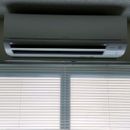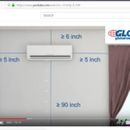Question about Mitsubishi minisplits
Original title: MSZ-GL09NA-u1 and MSZ-GL18NA-u1 with outdoor MXZ-3C24NA.
840 sq ft villa, 17 year old, with 2 mini-splits each directly above direct sunlight exposed 17 year old single pane 72×58″ windows, mounted nearly flush to flush to the ceiling – North Central Florida
Mitsubishi is sending a representative to my home tomorrow to review the layout that was done by one of their “Diamond” Contractors. There are many other issues with the installation to mention here, but from my experience it appeared that the installers were learning ON THE JOB, and/or, they had never installed TWO units in one residence, where the units were the ONLY HVAC in the home. Most of the mini-splits here in Florida are in lanais or garages, most homes have the standard ducted HVAC. The county Building Inspector who came out to my home was on my property a minimum of 5 mins before signing off on the installation. I am a single, self supporting female with NO mini-split installation experience. I chose and paid $1800 more than the next estimate for what I thought was Mitsubishi’s Diamond Contractor, someone who is supposed to know what they are doing. I was charged $7500 for the two indoor, one outdoor units. They used my existing ducted HVAC electrical equipment/hookup although I believe the $7500 included a brand new hook-up. The outdoor unit powered on/off for hours overnight because something was not properly connected at the hookup which was sparking. In the hopes of preventing mold build up, I chose the mini-splits BELIEVING I could clean the blower wheel myself, something I told the Diamond contractor during the estimate visit to my home. The outdoor unit, wider than the existing unit concrete slab, was placed so that a sprinkler head was between the outdoor unit and the wall of my home. The Diamond contractor who came to my home asked me “what do you want us to do about it?”. There’s more, but here are my questions:
1.Are 72×58 inch, single pane, 17 year old, windows in direct sunlight for hours considered a heat source? The installation instructions indicate positioning the indoor units “where it is away from the other heat or steam source” – Situation: remote set to 80, but inside temperature registers 70-72 degrees until the sun passes so that it is not beating on the east facing wall of the home. If I set the temp to 84-85 so that the outdoor unit isn’t working so hard to overcome the heat from the windows, and I forget to set it back to 79-80 before I leave, I come home to a stifling warm and humid environment.
2. Is it normal for both indoor units to require vacuum removal of algae (white/grey slimy matter) along with warm vinegar poured through condensation drain tray every two-three months, otherwise water drips from the front of the units until I perform the vacuum? The condensation line for the indoor unit closest to the outdoor unit runs parallel to the ground for 22″ before making the 90 degree bend to the ground. I don’t know if the installer ran the condensate line from the left or right of the farthest indoor unit, it may be more than 22″ horizontally before dropping to the ground.
3. Has anyone ever seen an installation layout like the one in the photo? The reason I am asking is that during Hurricane Irma last year, the storm approached from the east and rain pounded the east wall for hours. I have the bedroom window (furthest from the outdoor unit) blacked out most of the time so I wasn’t aware that the hole from the inside of my home to the outside hadn’t been properly sealed. When I discovered the carpet was wet under the window during the storm, I removed the black out materials and found the mini blinds covering the black out material were rusted at the top, and there was evidence of water intrusion at the bottom of the window panes. During the hurricane water from the unsealed hole saturated the entire top of the window and down both sides of the drywall, in addition to dripping onto the window sill and onto the carpet. I used a shop vac most of the night the storm hit to keep from having even more damage to the carpet. Note that there is ONE bundle coming from the bedroom indoor unit (farthest from the outdoor unit) in the horizontal tray housing that runs across the east wall, until reaching the second living room min-split (closest to the outdoor unit) which is when TWO bundles fill the housing – is it possible that 8 hours of water could have filled the empty portion of the housing which then poured into the hole of the bedroom unit? Or, was it just a matter of there being an unsealed hole, along with 8hrs of pounding, wind driven rain that allowed the water intrusion?
I have prepared an 18 page compilation of the installation instructions, along with photos of the water intrusion during the storm, have a jar of the algae (or whatever it is) saved to show the Mitsubishi representative. Another county Building Inspector did come to my home and shook his head at some of the things he witnessed that the first inspector didn’t catch, but because the board here is made up of HVAC contractors I have been unable to get any further response from the county.
Thank you for your time/responses…
GBA Detail Library
A collection of one thousand construction details organized by climate and house part












Replies
Susan,
I don't think that a single-pane window is considered a "heat source" (in the context of the document you're talking about), even though windows are clearly responsible for solar heat gain.
It looks like your indoor unit was installed too close the the ceiling.
I imagine that the penetrations through your wall could have been sealed better, although it's somewhat unfair to the contractor to use Hurricane Irma as an example of bad detailing. I've heard much, much worse Hurricane Irma stories that what you experienced.
Good luck with your efforts to resolve these issues.